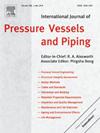Evaluation of test methodologies for assessing SCC-CO2 in tensile armor of flexible pipes
IF 3
2区 工程技术
Q2 ENGINEERING, MECHANICAL
International Journal of Pressure Vessels and Piping
Pub Date : 2025-03-19
DOI:10.1016/j.ijpvp.2025.105515
引用次数: 0
Abstract
A flexible pipe is constructed using multiple helicoidal metallic and polymeric layers, which give the pipe the necessary strength, and an outer polymeric layer that prevents contact of the transported fluid with seawater. This configuration allows greater flexibility than rigid risers with the same pressure capacity. One of the layers of the flexible pipe is the tensile armor, which is composed of two or four layers of metallic wires that provide axial resistance when the pipe is subjected to internal or external pressure. They are coiled in opposite directions to generate torsional resistance. The National Petroleum Agency, ANP, reported the occurrence of stress corrosion cracking in a flexible gas injection pipeline in its second year of operation, despite having 20 years of lifespan. The failure occurred due to the entry of water and CO2 into the annular space. The main objective of this work is to assess laboratory methodologies for SCC-CO2 evaluation in a carbon steel wire of a flexible pipeline, at CO2 pressure of 10,6 barg, 40 °C and V/S of 1 mL/cm2 in synthetic seawater. This condition is known to provoke SCC-CO2 failures. The methodologies were: slow strain rate tests, four-point bend test, constant load test and alternating load test, which is the new methodology proposed in this paper. We have observed that SCC-CO2 occurs by successive localized ruptures of FeCO3 layer, which is addressed in the alternating load test.
评估柔性管道拉伸护甲中SCC-CO2的试验方法的评价
柔性管道由多层螺旋金属层和聚合物层构成,这给管道提供了必要的强度,外层的聚合物层可以防止输送的流体与海水接触。这种配置比具有相同压力能力的刚性立管具有更大的灵活性。柔性管的其中一层是拉伸护甲,它由两层或四层金属丝组成,当管道受到内部或外部压力时,金属丝提供轴向阻力。它们以相反的方向盘绕以产生扭转阻力。尼日利亚国家石油局(ANP)报告称,一条使用寿命长达20年的柔性注气管道在运行的第二年发生了应力腐蚀开裂。故障发生的原因是水和二氧化碳进入环空空间。这项工作的主要目的是评估实验室方法,在合成海水中,在二氧化碳压力为10,6巴,40°C, V/S为1 mL/cm2的情况下,在柔性管道的碳钢丝中评估SCC-CO2。已知这种情况会引起SCC-CO2失效。试验方法包括:慢应变速率试验、四点弯曲试验、恒载试验和交变荷载试验,这是本文提出的新方法。我们观察到SCC-CO2是由FeCO3层的连续局部断裂引起的,这在交变载荷试验中得到了解决。
本文章由计算机程序翻译,如有差异,请以英文原文为准。
求助全文
约1分钟内获得全文
求助全文
来源期刊
CiteScore
5.30
自引率
13.30%
发文量
208
审稿时长
17 months
期刊介绍:
Pressure vessel engineering technology is of importance in many branches of industry. This journal publishes the latest research results and related information on all its associated aspects, with particular emphasis on the structural integrity assessment, maintenance and life extension of pressurised process engineering plants.
The anticipated coverage of the International Journal of Pressure Vessels and Piping ranges from simple mass-produced pressure vessels to large custom-built vessels and tanks. Pressure vessels technology is a developing field, and contributions on the following topics will therefore be welcome:
• Pressure vessel engineering
• Structural integrity assessment
• Design methods
• Codes and standards
• Fabrication and welding
• Materials properties requirements
• Inspection and quality management
• Maintenance and life extension
• Ageing and environmental effects
• Life management
Of particular importance are papers covering aspects of significant practical application which could lead to major improvements in economy, reliability and useful life. While most accepted papers represent the results of original applied research, critical reviews of topical interest by world-leading experts will also appear from time to time.
International Journal of Pressure Vessels and Piping is indispensable reading for engineering professionals involved in the energy, petrochemicals, process plant, transport, aerospace and related industries; for manufacturers of pressure vessels and ancillary equipment; and for academics pursuing research in these areas.

 求助内容:
求助内容: 应助结果提醒方式:
应助结果提醒方式:


